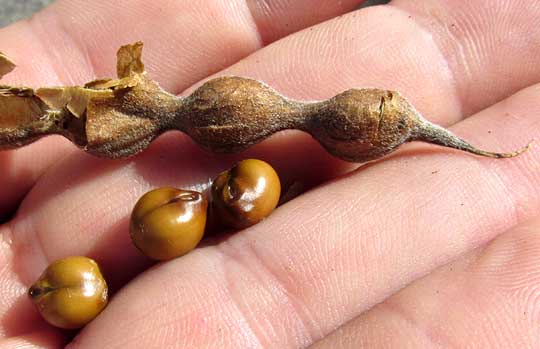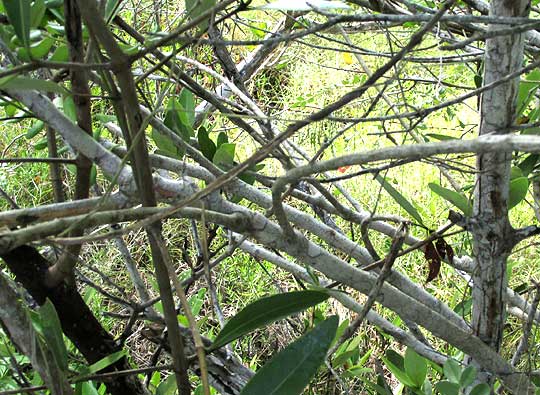Excerpts from Jim Conrad's
Naturalist Newsletter

from the November 9, 2014 Newsletter issued from Río Lagartos, on the Yucatan Peninsula's northern coast (~N21.60°, ~W88.16°), Yucatán state, MÉXICO
NECKLACEPOD
In the dense, waist-high tangle of scrub stabilizing salt-saturated dunes along the coast just east of Río Lagartos a compact shrub draws attention to itself nowadays with the handsome racemes of fair-sized, yellow flowers, as shown above.
With its reclining habit and large, pinnately compound leaves, except for the flowers' color, this could be a Wisteria. Notice that immature, slender, green-bean-type legumes emerge from calyxes at the bottom of the raceme where old flowers have lost their corollas, just like Wisteria. Both this plant and Wisteria belong to the Bean Family, the Fabaceae, so the similarities are not incidental. A close-up of a flower is shown below:

That's a classic Bean-Family type flower, one that's "papilionaceous," which means that the corolla consists of five petals, of which the top one is enlarged and rises above the others, there are two side petals called "wings," and the two lower petals are fused along their common border to form a scoop-like structure called the "keel." An important difference between this flower and those of Wisterias is that the stem-like filaments of this flower's ten stamens are separate from one another, while in Wisteria blossoms the filaments of nine stamens are joined together, with the tenth stamen separate. Among botanists, such differences in flower structure are monumental, so, despite the superficial similarities, Wisterias and this plant don't even belong to the same tribe within the Bean Family.
This handsome, salt-tolerant, dune-loving bush can be found on many of the world's tropical and subtropical coasts, so it's known by many English names, including Yellow Necklacepod, Yellow Sophora, Necklace Pod, Silverbush, Seaside Pigeon Pea and Tambalisa. It's SOPHORA TOMENTOSA, which in the US occurs only on the coasts of Texas and Florida. The "necklace" part of some of its names refers to the long legumes that for much of the season dangle from stems, the legumes constricted between the beans, looking like beads on a string.
This is such a tough, pretty bush with flowers that attract hummingbirds that it's often sold in plant nurseries up north, though it's freeze intolerant.
Often the plant is employed in traditional medicine, for problems ranging from cholera, food poisoning and breast cancer to venereal diseases, depending on the culture. There might be something to some of the uses because the seeds are regarded as poisonous due to the presence of a cystisine called sophorine, and other compounds related to nicotine. In fact, all parts of the plant contain some poisonous alkaloids. Its juice is used as fish poison in East Africa, and as an insecticide in Fiji.
from the January 11, 2015 Newsletter issued from Río Lagartos, on the Yucatan Peninsula's northern coast (~N21.60°, ~W88.16°), Yucatán state, MÉXICO
NECKLACEPOD WITH ITS NECKLACEY PODS
Back in November the bush offered no hint as to why it was called Necklacepod, but now during its fruiting season it does. Below you can see a bush-tip cluster of this Bean Family member's dangling legumes constricted between their beans like a bead necklace:

A mature legume with some of its tan-colored, pea-like beans is shown below:

Another shot showing how the bush's stems lean into and entangle themselves among upright stems of other woody species is shown below:

Necklacepod's handsome beans are, as the MedicinalPlantsHerb.Com website says, "dangerously emetocatharitc, toxic, febrifugal, stomachic," loosely translated as meaning that if used right they might improve digestion and bring a fever down, but in too large a dosage might bring forth a violent bout of vomiting, or worse. However, elsewhere it's to be read that the Chinese prepare from the plant's roots an "esteemed tonic" that also serves as a diuretic (makes you pee) and a pectoral (helps with lung problems).
Usually when such a plant enjoys traditional use as a medicinal plant the Internet abounds in pages selling it. Not so with Necklacepod, and I suppose that that means its chemicals are so powerful that no one dares sell them, even on the Internet.